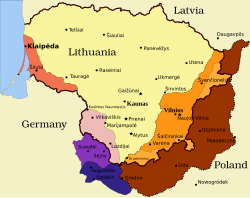Kingdom of Lithuania (1918)
| Kingdom of Lithuania | ||||||||||||
| Lietuvos Karalystė | ||||||||||||
| Client state of the German Empire | ||||||||||||
|
||||||||||||
| Capital | Vilnius | |||||||||||
| Languages | Lithuanian | |||||||||||
| Government | Monarchy | |||||||||||
| King | Mindaugas II | |||||||||||
| Legislature | Council of Lithuania | |||||||||||
| Historical era | World War I | |||||||||||
| • | Lithuanian independence | February 16, 1918 | ||||||||||
| • | Treaty of Brest-Litovsk | March 3, 1918 | ||||||||||
| • | Recognized by Germany | March 23, 1918 | ||||||||||
| • | Monarch elected | July 11, 1918 | ||||||||||
| • | Monarchy suspended | November 2, 1918 | ||||||||||
| • | German surrender | November 9, 1918 | ||||||||||
|
||||||||||||
The Kingdom of Lithuania was a short-lived constitutional monarchy created towards the end of World War I when Lithuania was under occupation by the German Empire. The Council of Lithuania declared Lithuania's independence on February 16, 1918, but the Council was unable to form a government, police, or other state institutions due to the continued presence of German troops. The Germans presented various proposals to incorporate Lithuania into the German Empire, particularly Prussia. The Lithuanians resisted this idea and hoped to preserve their independence by creating a separate constitutional monarchy. On June 4, 1918, they voted to offer the Lithuanian throne to the German noble Wilhelm, 2nd Duke of Urach. Duke Wilhelm accepted the offer in July 1918 and took the name Mindaugas II. However, he never visited Lithuania. His election stirred up controversy, divided the Council, and did not achieve the desired results. As Germany was losing the war and was engulfed in the German Revolution, Lithuania suspended its decision to invite Duke William on November 2, 1918, thereby ending his short reign.
After the last Partition of the Polish–Lithuanian Commonwealth in 1795, Lithuania was annexed by the Russian Empire. In 1915, during World War I, Germany occupied western parts of the Russian Empire, including Lithuania. After the Russian Revolution in 1917, Germany conceived the geopolitical strategy of Mitteleuropa, a regional network of puppet states that would serve as a buffer zone. The Germans allowed the organisation of the Vilnius Conference, hoping that it would proclaim that the Lithuanian nation wanted to detach itself from Russia and establish a "closer relationship" with Germany. In September 1917, the Conference elected a twenty-member Council of Lithuania and empowered it to negotiate Lithuanian independence with the Germans. The Germans were preparing for the upcoming negotiations for the Treaty of Brest-Litovsk and sought a declaration from the Lithuanians that they wanted a "firm and permanent alliance" with Germany. Such a declaration was adopted by the Council of Lithuania on December 11, 1917. However, these concessions divided the Council and still did not earn recognition from Germany. Therefore, the Council adopted the Act of Independence of Lithuania on February 16, 1918. The Act omitted any mention of alliance with Germany and declared the "termination of all state ties which formerly bound this State to other nations." On March 3, 1918, Germany and Bolshevik Russia signed the Treaty of Brest-Litovsk, which declared that the Baltic nations were in the German interest zone and that Russia renounced any claims to them. On March 23, Germany formally recognized independent Lithuania on the basis of the December 11 declaration. However, the country was still occupied by German troops, the Council still did not have any actual power and it was treated just as an advisory board by the Germans.
...
Wikipedia


